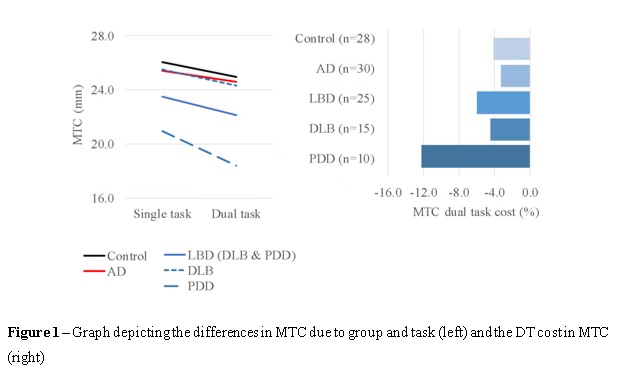Session Information
Date: Monday, October 8, 2018
Session Title: Parkinson's Disease: Cognition
Session Time: 1:15pm-2:45pm
Location: Hall 3FG
Objective: To evaluate the change in gait and minimum toe clearance when walking under dual task in different dementia sub-types as a contributor to dynamic falls risk.
Background: Dementia is one of the most common neurodegenerative disorders in older adults affecting 46.8 million people worldwide [1]. Recurrent falls are common in people with Alzheimer’s disease (AD; 26%), Dementia with Lewy Bodies (DLB; 40%) and Parkinson’s disease dementia (PDD; 73%)[2]. A reduced minimum toe clearance (MTC) may contribute to dynamic falls risk and may be further exacerbated when cognitive resources are challenged.
Methods: Four groups were assessed: AD (n=30), DLB (n=15), PDD (n=10) and controls (n=28). Participants performed 6 x 10m walks under single (ST) and dual (DT; maximal digit span) task conditions. Temporal spatial gait characteristics were measured using an instrumented walkway and MTC was quantified using 3D motion capture. DT cost was calculated ((ST – DT)/ST)*100. Differences in gait and MTC due to task and group were evaluated using a General Linear Model controlling for sex.
Results: Falls prevalence in the patient groups was 33% in AD, 60% in DLB and 80% in PDD. There were no significant differences in gait or MTC between the DLB and PDD groups during ST or DT so the groups were collapsed (Lewy body disease; LBD n=25). Participants walked slower, with a shorter step length, increased stance time, wider step and a lower MTC during DT (p<.007). Similarly, a lower MTC was observed during DT irrespective of group (p=.027). Significant differences in gait and MTC were highlighted between controls and both patient groups (p<.05) but not between patient groups (AD vs. LBD) [Figure 1]. Further investigation of MTC [Figure 1] revealed that the largest DT cost in MTC was observed in the PDD group (~12%) compared to AD (~2%) and DLB (~4%) however this difference was not significant.
Conclusions: Over short intermittent walks, AD and DLB groups presented with comparable temporal-spatial gait and MTC and this was not influenced by the addition of a dual task. Gait deficits were evident in dementia groups irrespective of cognitive challenge. MTC deficits are exacerbated under DT in PDD and this may contribute in part to the increased falls prevalence in PDD compared to other dementia sub-types reflecting the dynamic nature of fall risk factors.
References: [1] Prince et al., (2015). World Alzheimer Report 2015. The global impact of dementia. An analysis of prevalence, incidence, cost and trends, Alzheimer’s Disease International, London. [2] Allan et al., (2009). Incidence and prediction of falls in dementia: A prospective study in older people. PLOS ONE.
To cite this abstract in AMA style:
L. Alcock, R. McArdle, L. Aubrook, B. Galna, A. Thomas, L. Rochester. Dual task walking differentially affects toe clearance in Lewy body disease: A contributor to dynamic falls risk? [abstract]. Mov Disord. 2018; 33 (suppl 2). https://www.mdsabstracts.org/abstract/dual-task-walking-differentially-affects-toe-clearance-in-lewy-body-disease-a-contributor-to-dynamic-falls-risk/. Accessed July 11, 2025.« Back to 2018 International Congress
MDS Abstracts - https://www.mdsabstracts.org/abstract/dual-task-walking-differentially-affects-toe-clearance-in-lewy-body-disease-a-contributor-to-dynamic-falls-risk/

